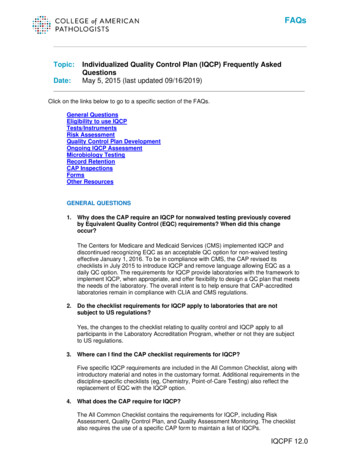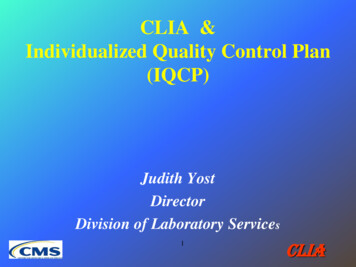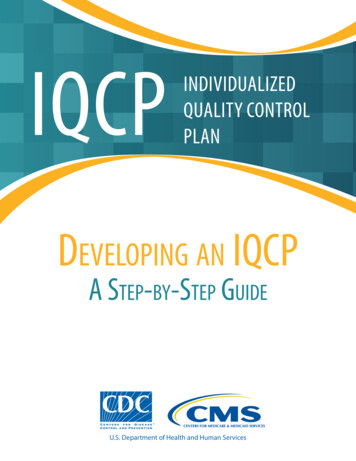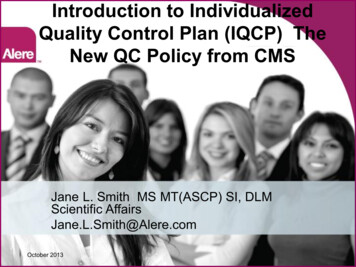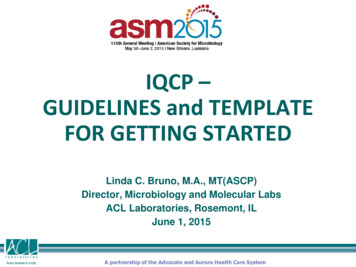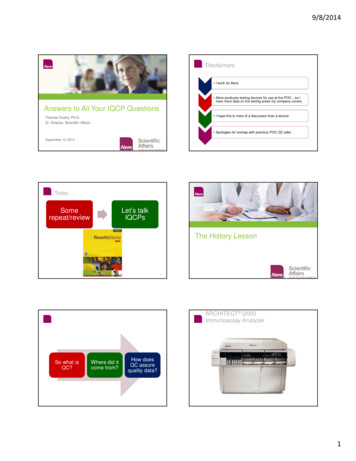
Transcription
9/8/2014Disclaimers I work for Alere Alere produces testing devices for use at the POC so Ihave more data on the testing areas my company covers.Answers to All Your IQCP Questions I hope this is more of a discussion than a lecture.Thomas Koshy, Ph.D.Sr. Director, Scientific Affairs Apologies for overlap with previous POC QC talksSeptember 10, 2014Today .Somerepeat/reviewLet’s talkIQCPsThe History LessonIQCP2ARCHITECT i2000Immunoassay AnalyzerSo what isQC?Where did itcome from?How doesQC assurequality data?1
9/8/2014The Regulations 493.1256 – QC proceduresThe epoc SystemFor each test system, the laboratory musttest, at a minimum, two levels of externalQC materials each day it performs anonwaived test.epoc BGEMTestCardepoc Readerepoc HostMobileepoc DataManagerRoom temp storage11 measured results10 calculated results 30 second test timeHowever, the regulations now allowthe laboratory to reduce thefrequency of testing external QCmaterials (equivalent QC procedure)for certain test systems.CLIA9CMS: Equivalent Quality Control Procedures Brochure #4epoc QC ChecksOther epoc QC ChecksEvery time the Host and Reader connect, the Readerundergoes an automatic, 2 level, electronic QC test.An audible beep is produced whenadequate sample is applied to the card.This will repeat every 8 hours if needed.The system will flag the following conditionsand not deliver a test result when:The Reader monitors the testing environment: The operating conditions are 15 -30 C, 400-825 mm Hgatmospheric pressure and 85% humidity. The Reader has internal thermometers and barometers andwill shut down if these ranges are exceeded. The internal QC checks will fail if humidity is 85Using an expired cardRerunning an already used test cardPutting in too little sampleIntroducing the sample too rapidly, too slowly orsample with an air bubble. Introducing the sample at the wrong time2
9/8/2014493.1256 – QC proceduresFor each test system, the laboratory musttest, at a minimum, two levels of externalQC materials each day it performs anonwaived test.However, the regulations now allowthe laboratory to reduce thefrequency of testing external QCmaterials (equivalent QC procedure)for certain test systems.EQC EvaluationEvaluation ProcessOption 1System monitors allanalytic componentsExternal QCchecksDaily testing with10 consecutiveinternal monitoring days of passingsystemsexternal QCAt least onceper monthOption 2Daily testing with30 consecutiveSystem monitors some internal monitoring days of passingsystemsexternal QCanalytic componentsAt least onceper weekOption 3System monitors noanalytic componentsAt least onceper weekNA60 consecutivedays of passingexternal QCCLIACMS: Equivalent Quality Control Procedures Brochure #4CMS: Equivalent Quality Control Procedures Brochure #4Normal Population Distributions 2 SD captures 95% of data(0.95).ρ passing 10 reps 0.9510 0.598.0.9530 0.215ρ passing 10/11 reps 0.897 1 SD captures 68% of data 2 SD captures 95% of data 3 SD captures 99.7% of data3/9/12 CMS Official MemorandumKey concepts from EP-23 will be an acceptable alternativeQC policy. The New CLIA QC policy will be entitledIndividualized Quality Control Plan (IQCP)CLSI to the Rescue!!!EP23User Defined QCProtocols for In VitroDiagnostic DevicesBased onManufacturer’s RiskMitigation Informationand the User’sEnvironmentEP18Risk ManagementTechniques toIdentify and ControlLaboratory ErrorSourcesCLSI. Laboratory Quality Control Based on Risk Management; Approved Guideline. CLSIdocument EP23-A. Wayne, PA: Clinical and Laboratory Standards Institute; 2011.Remember EP23IQCPIQCPs are a formal representation and compilation ofmany things laboratories currently do for quality.IQCPs permits the laboratory to customize its QC planaccording to environment, reagents, testing personnel,specimens, and test system.IQCP will be voluntary: Laboratories will have two choicesfor QC compliance: 1) Two levels of QC per day or, 2)IQCP. Package insert requirements must be met. CMS/CLIA Website:http://www.cms.hhs.gov/clia/ CMS CLIA Central Office:410.786.3531 IQCP Link:IQCP@cms.hhs.govEducation period:1/1/14-1/1/16EQC will be phased out at the end of the education andtransition periodEP23IQCP EP23 Workbook173
9/8/2014Accrediting Agencies UpdatesAccreditedlaboratories shouldcontinue to meettheir accreditingorganizations’ QCstandards untilthey receive noticefrom their AOs.CMS will solicitaccreditingorganizations (AOs)to determine theirinterest in IQCP.COLA bepresentedcriteria in June18, 2014webinarTJC introducednew IQCPStandard onMarch 24, 2014Laboratories mayuse CLIA QCregulations,EQC, or IQCPCAPrequirementswill bepublishedwith the July2015checklistupdatesNo word yet from somestates with deemed status:NY, PA, OR, etc.EP23 Companion ProductsA step-by-steprisk assessmentof your entiretest processModules that are custom designedfor each POC test device, prepopulated with the latest IVDmanufacturer's specificationsReports that will help you substantiateyour program, facilitate validations, andorganize the information you'll need todefend your IQCP's during inspectionsAn IQCPdevelopment processthat encourages acommittee approachCustomize your QC Plan according to testmethod, utilization, environmental factors, andpersonnel competency to produce a QC planthat is clinically and economically beneficialOptimize yourcurrent QC/QAprocessesAdhere to federal, stateand accreditingorganization requirementsEnsure continuousquality patient care, withoptimal clinical outcomesIdentifying new initiatives andongoing measures to improvethe quality of patient careCDC Guide to IQCP Coming CLSI. Laboratory Quality Control Based on Risk Management; Approved Guideline. CLSIdocument EP23-A. Wayne, PA: Clinical and Laboratory Standards Institute; 2011.Not theConclusionsWhat Can We Expect fromInspectors?TheProcess234
9/8/2014QualityAssessmentRisk AssessmentQualityAssessment Process to identify l PanIQCPQuality Control Plan List of errors and actionsto mitigage the risksQuality Assessment Monitoring of that planLife-Cycle Risk Management Process24Was the IQCPdeveloped with inputfrom the rightpersonnel?Were the data used inthe Risk Assessmentof reasonablequantity and quality?What are Risk Assessments?Is there a process tomonitor and reviewQuality performance?26Ask .Whatcould gowrong?Howlikely isit tohappen?Howbadcould itget?Whatcontrolsdo Ihave inplace?Life-Cycle Risk Management Process295
9/8/2014Risk Management 101Understand the difference betweenhazard and riskUnderstand that the hazard from anincorrect test result may NOT be DEATHHowlikely isit tohappen?Whatcould gowrong?Whatcontrolsdo Ihave inplace?Howbadcould itget?Understand that youcannot eliminate risk30Risk Assessment Tools31Testing Process Fishbone DiagramArrival to /ED Lab marker TAT Time to treatment Brainstorming Presentation of symptomsIntervention5 Whysfrom marker Intervention Prep TimeFishbone diagrams Time to evaluation/test ordering Timereceipt to diagnosis (i.e. time fromdiagnosis to cath labnotification andProcess uottingRelease/reportPost-analyticalMD orders testMD icalInstrument analysisAnalyticalG. Cooper, BioRad. 2007 AACC QC WebinarRisk Management approach to QCVariables to ConsiderAsk the right questions What is needed to assure quality of test results? Does the manufacturerrecommendation for QC minimize laboratory risk to an acceptable level? What are the key conditions or potential failures that could occur in thelaboratory that pose risk of harm to the patient? What is controlled/not controlled? Are validation/verification studies sufficiently Intended medicaluse of test result:HIV vs triglycerideClinical setting: Mainlab, POC,Outpatient, ER, ICU,Ambulance, Nontraditional settingTime lapse: Areresult acted onimmediately or not?Testing frequency,testing personneland turnoverCondition of ancillaryequipment:Centrifuges,refrigerators, heatbathsPower requirements/fluctuationsRadio andelectromagneticwavesAge of the device Are EQC features sufficient to protect patient from harm? How frequently (time and replicates) should QC be tested?G. Cooper, BioRad. 2007 AACC QC WebinarG. Cooper, BioRad. 2007 AACC QC Webinar6
9/8/2014Ask .Think in terms of the five elements of als(ReagentsEquipmentand(Hardwareconsumables):and titutionReliability, Preparation(mixing), ificity,Accuracy,PrecisionHowlikely isit tohappen?Whatcould gowrong?Environment:Temperature,Humidity, Airflow, Powersupply, WaterqualityWhatcontrolsdo Ihave inplace?Howbadcould itget?BTW: This is committee work!37G. Cooper, BioRad. 2007 AACC QC WebinarRanking Severity of Failure andProbability of HarmNegligible Inconvenience or temporarydiscomfortMinorFrequentProbabilityof harmFrequentProbable Once per monthSeriousOccasional Injury or impairment requiringprofessional medical intervention Once per yearRemoteCriticalSeverity of Harm Once per week Temporary injury or impairment notrequiring professional medicalintervention Permanent impairment or lifethreatening injuryRisk Acceptability MatrixSeriousCritical emoteOKOKOKOKXImprobableOKOKOKOKOK Once every few yearsImprobableCatastrophic Once in the life of the test system Results in patient deathISO 14971ISO 14971Process Severity Evaluation CriteriaEffectSeverity of effectHazardous, without warning May endanger patient. Involves non-compliancewith gov’t. regulation without warning.Hazardous, with warningSame as above only with warningProcess Occurrence Evaluation CriteriaRanking1098HighMajor injury to patient requiring emergencyinterventionMinor injury to patient; patient dissatisfiedModerateResults acceptable; not cosmetically satisfactory6Low100% of results may have to be retested; somepatient dissatisfactionTiming/efficiency defects noticed by most users5Same as above, but, defect noticed by averageuserSame as above, but, defect noticed only by thediscriminating userNo effect3Very HighVery LowMinorVery MinorNoneNegligible MinorAdapted from Quality Support Group, Inc742Probability ofFailurePossible FailureRatesVery high, failure isalmost inevitable 1 in 2High, repeatedfailuresModerate, occasionalfailuresLow, relatively fewfailuresRemote, unlikelyCpkRankings1 in 3 0.33 0.331091 in 81 in 20 0.51 0.6787 0.83 1.00 1.17 1.33 1.50 1.676543211 in 801 in 4001 in 20001 in 15,0001 in 150,000 1 in 1,500,0001Adapted from Quality Support Group, Inc7
9/8/2014Process Detection Evaluation CriteriaQualitative probabilityRemote likelihood that erroneous resultswould be undetected detection reliability at least 99.99% detection reliability at least 99.80%Low likelihood that erroneous resultswould be undetected detection reliability at least 99.5% detection reliability at least 99%Moderate likelihood of detection detection reliability at least 98% detection reliability at least 95% detection reliability at least 90%High likelihood that that erroneousresults would be undetected detection reliability at least 85% detection reliability at least 80%Extreme likelihood that erroneousresults would be undetectedQuantitative probability Rankingof not 001/1005671/501/20891/10 10Then the Quality Control PlanAdapted from Quality Support Group, IncNow .What Needs Fixing? Identify those conditions that lead to unacceptablelevels of error severity and frequency. Determine operating processes or tests (qualitycontrol) to detect those conditionsWhatcould gowrong?Howlikely isit tohappen?Howbadcould itget?Whatcontrolsdo Ihave inplace?1st2nd3rd4th Eliminate causes of failure so that it does not OCCUR Reduce probability of OCCURRENCE Reduce SEVERITY of the failure Improve DETECTION of the failure44Quality Support Group, IncA Triage ExampleEach Triage device has abarcode that containscritical information,including expiration date.Other Resources ISO (www.iso.org) ISO 9000:2005 Quality Management systems-Fundamentals andvocabulary ISO 14971:2007 Medical Devices-Application of risk management tomedical devices But how are you supposed to understand all the instrument featuresDevices are stored at 2-8degrees C and must bebrought to RT for use.that could mitigate risk?Once at room temperature,the devices are stable for14 daysJ Westard, Westard QC, Inc and G. Cooper, BioRad. 2007 AACC QC Webinar8
9/8/2014Vendor IssuesLabswouldlike .What Will Vendors do to SupportIQCPs? Full descriptions ofhazards, failures, risksand potential clinicalimpactVendorsboundby . Anything put inwriting could beinterpreted as aclaim No vendorcanprovide afull IQCPfor a labWeknow 49PackageInsertSo How Do We mentLabInformationClinicalRequirementsThink of Your Testing ProcessPre-analyticalWhat Can I Do to Prepare for IQCPs?HistoricalDataEvaluatethe Actualor theFrequencyof FailuresIdentifyFailuresWhere theFailuresOccurredCLSI. Laboratory Quality Control Based on Risk Management; Approved Guideline. CLSIdocument EP23-A. Wayne, PA: Clinical and Laboratory Standards Institute; 2011.9
9/8/2014EP23 Workbook Key Process Steps1. Operator training and competency2. Reagent/calibrator/parts procurement and3.4.5.6.7.8.storagePatient sample acceptability evaluationSystem startupSystem calibrationLoading and testing of patient samplesProper device functionTest result reviewIn Summary .CLSI. Laboratory Quality Control Based on Risk Management; Approved Guideline. CLSIdocument EP23-A. Wayne, PA: Clinical and Laboratory Standards Institute; 2011.As a Result You WillIdentify each componentand its functionIdentify the potentialfailure mode for eachcomponentIdentify the potentialeffect(s) of the failureand rate the severity ofeachIdentify the potentialcauses of the failure andrate the occurrence ofeachIdentify the currentcontrol for eachoccurrence and rate thedetection capabilityCalculate the RPN foreach itemRank RPNs from highestto lowestTake action on thoseitems designated ashigh riskLife-Cycle Risk Management ProcessG. Cooper, BioRad. 2007 AACC QC WebinarThis is the future for QC of POCTA Risk Management approach to Quality ControlQuestions?Thank You!No more onesize-fits-allformulasEvaluate theQC features ofthe deviceAnalyze otherelements ofvariability thatmust becontrolledAssess theseverity offailures in eachstep of thetesting processDevice QCtesting tomonitor andcatch saidfailuresThis is a shift from “Quality Compliance” to trueQuality ControlToday is the youngest you’ll be for the rest of your life. Act like it.10
Alere produces testing devices for use at the POC so I have more data on the testing areas my company covers. I hope this is more of a discussion than a lecture. Apologies for overlap with previous POC QC talks Today . Some repeat/review Let's talk IQCPs 2 IQCP The History Lesson So what is QC?
